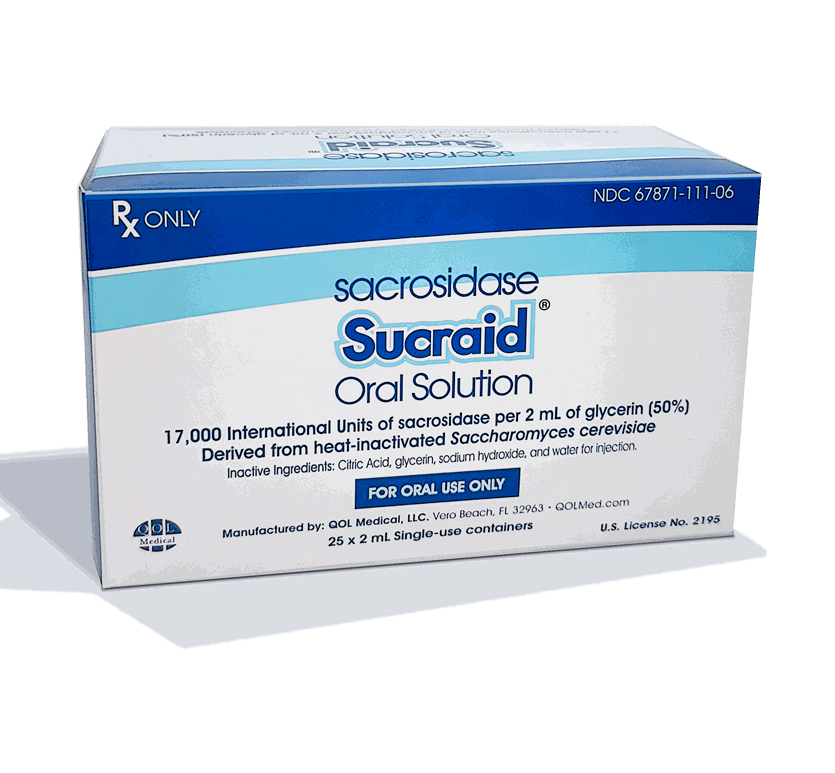Taking Sucraid®
Dosage and Administration
Please follow the dosing instructions for Sucraid® carefully.
In This Section
Sucraid® is Supplied in Bottles and Single-Use Containers
- Sucraid® bottles are available for patients with a body weight of 33 lb (15 kg) or less
- Sucraid® single-use containers, which dispense a 2-mL dose, are available for patients with a body weight greater than 33 lb (15 kg)
Dosing Instructions for Sucraid® Bottles:
- 1 mL (8,500 IU; one full measuring scoop; use the white plastic scoop provided in your box of Sucraid®) per meal or snack for infants, toddlers, and small children weighing up to 33 lb (15 kg)
Each Sucraid® dose should be diluted in 2 to 4 ounces of water, milk or infant formula. Sucraid® can be measured with the white, plastic, 1-mL measuring scoop that is provided.
It is recommended that approximately half the dosage be taken at the beginning of each meal or snack and the remainder of the dosage taken during the meal or snack. Sucraid® acts on the food you eat while it is in your gastrointestinal (GI) tract. Therefore, it is important that Sucraid® be taken when you are eating.
If you still have some symptoms after starting therapy with Sucraid®, your doctor may recommend avoiding starchy foods for several weeks and then gradually adding back foods containing starch while monitoring your GI symptoms.

Figure 1. Sucraid® single-use container (pictured). Also available in bottle form.
Administration, Storage, and Shelf Life of Sucraid® Bottles
The following should be noted with regards to administration, storage, and shelf life of Sucraid®:
- Sucraid® is a substitute for the missing sucrase enzyme, so it must be taken with every meal or snack to work. Half of each dose should be taken before a meal and the other half during a meal
- The beverage or infant formula used to dilute Sucraid® should be served cold or at room temperature. Do not heat beverages containing Sucraid®, or add Sucraid® to hot beverages, as the heated fluid could decrease the potency of the enzyme
- Sucraid® should be refrigerated at 36°F to 46°F (2°C to 8°C) and protected from heat and light
- Sucraid® should not be consumed with fruit juices, as the acidity may impair enzyme activity
- Sucraid® should not be taken directly from the bottle or measuring scoop without first diluting in water, milk, or infant formula
- Discard bottles of Sucraid® four weeks after first opening, because, as with all proteins, there is the potential for bacterial growth
Traveling with Sucraid® Bottles
Sucraid® should be kept refrigerated at 36°F to 46°F (2°C to 8°C) and should be protected from heat and light. For this reason, traveling with Sucraid® can be difficult. Parents and caregivers of patients with Congenital Sucrase-Isomaltase Deficiency (CSID) have used a variety of techniques to facilitate travel with Sucraid®.
Common travel ideas for transporting a Sucraid® bottle are:
- A cooler with reusable ice gel packs or ice blocks (the bottle should be wrapped in an insulated lunchbox or protective compartment so Sucraid® will not freeze completely if using dry ice)
- Insulated lunchboxes with reusable ice gel packs or ice blocks
- Medical coolers
- A wide-mouthed thermos-type bottle, packed with ice
- Insulated bags intended for baby bottles
- Insulated bags with coolant inside that allows the entire bag to be frozen before inserting the Sucraid® bottle
Discover the Convenience of Sucraid® Single-Use Containers
- An on-the-go option is Sucraid® single-use containers
- These containers contain the correct individual dose of Sucraid® for patients whose body weight is greater than 33 lb (15 kg)
- Small enough to fit in your pocket
- Sucraid® single-use containers can be removed from refrigeration and stored at 59°F-77°F (15°C-25°C) for up to 3 days (72 hours).
Dosing Instructions for Sucraid® single-use containers
- No measuring required
- Just twist, squeeze, and mix
Letter of Medical Necessity for Sucraid® Bottles
Traveling by plane with Sucraid® can also prove to be challenging. The U.S. Transportation Security Administration (TSA) permits “prescription liquid medications and other liquids needed by persons with disabilities and medical conditions. This includes all prescription and over-the-counter medications. This also includes gels or frozen liquids needed to cool disability- or medically-related items used by persons with disabilities or medical conditions.” Sucraid® can go through the X-ray machine as part of the security process without the scan affecting the ability of Sucraid® to continue working.
People have found that the burden of traveling with Sucraid® is reduced when a physician provides them with a Letter of Medical Necessity. The Letter of Medical Necessity should include the following information:
-
-
- Patient’s name
- Patient’s date of birth
- Patient’s diagnosis of CSID
- Patient’s need for therapy with Sucraid®
- The need for Sucraid® to be refrigerated/maintained at 36°F to 46°F (2°C to 8°C)
- The need for any ice gel packs or ice blocks to be kept with the Sucraid® at all times
-
Traveling with Sucraid® poses some unique challenges. For longer trips, it is advised to find out if your destination has a refrigerator available.
Please click this link to access a sample Letter of Medical Necessity to use during travel, which patients can bring to their healthcare provider for his/her signature.




